When you start a project, you might think it will go a certain way, and you might hope it goes a certain way … but you have absolutely no assurances it will turn out as you think and hope it does.
Well, some 5 1/2 years in the making, our real-money Income Builder Portfolio did everything we envisioned — and more.
Mostly by using the Dividend Growth Investing strategy, we sought to put together a portfolio capable of generating $5,000 in annual passive income within 7 years of the IBP’s inception — and that target was reached with 18 months to spare!

SimplySafeDividends.com
And we wanted to achieve our income goal without making a big total-return sacrifice. Mission accomplished there, too.
As the following chart lifted off of the IBP’s brokerage statement shows, the portfolio’s annual rate of return from its inception through June 30 was 10.59%, well ahead of the 7.75% ROR for the Dow Jones Industrial Average and just a touch behind the 10.9% of the S&P 500.
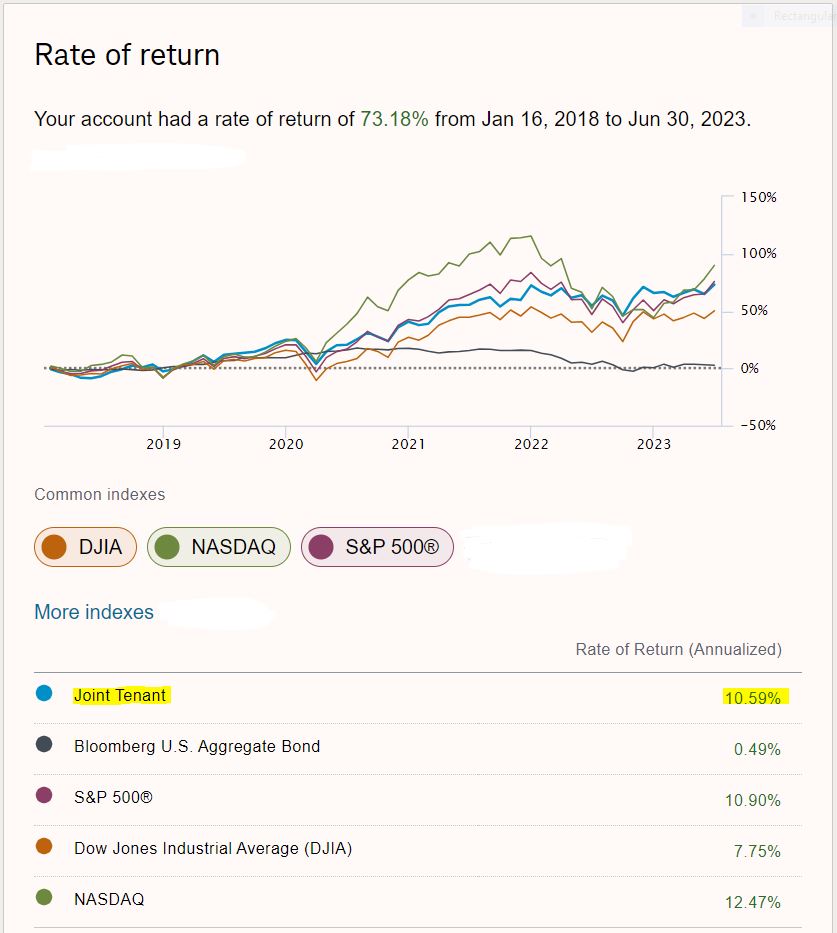
The U.S. Aggregate Bond Index barely gained at all. That matters because tens of millions of investors hold balanced mutual funds with 60/40 or 70/30 stock/bond mixes, and the IBP handily beat those.
For example, Vanguard’s venerable Wellington Fund, which has roughly a 66/34 blend, had an average annual return of about 8% over the span. The approximate 60/40 mix in the JPMorgan Smart Retirement 2030 Fund — representative of “target-date funds” held by millions of 401(k) investors — produced only about 5% total return.
Yes, when one focuses on buying high-quality, dividend-growing stocks at fair (or preferably better) valuations, DGI works superbly.
My colleague, Dave Van Knapp, has shown that to be true with his Dividend Growth Portfolio, which has been going strong for 15+ years. And the Dividend Growth 50 portfolio that I ran for more than 8 years served as another example of outstanding income growth and competitive total return.
I’m not saying that DGI is the best strategy or one that everybody should use. There are lots of ways to “win” at investing. I’m simply stepping beyond the theoretical by providing real-world examples — including our IBP — that DGI can be a very effective way to invest.
As satisfying as it is to look back at the Income Builder Portfolio’s performance during its first phase, I urge you to keep reading this article all the way through for still more exciting news.
Let’s Talk Income
First, let’s look at relevant data relating to the 52 positions (51 stocks, 1 certificate of deposit) that made up the IBP on June 30, 2023:
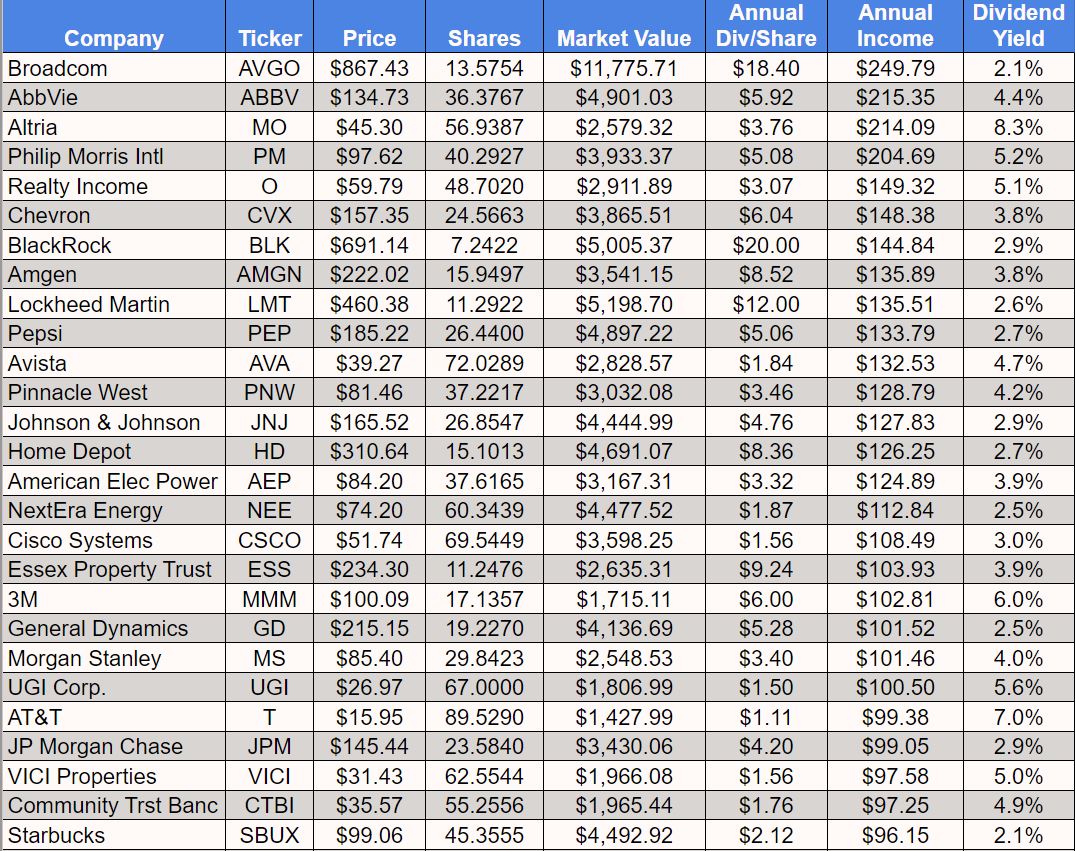

(The table above is updated regularly on our IBP Home Page HERE.)
As stated in the IBP Business Plan, the goal was to “build a reliable, growing income stream by making regular investments in high-quality companies, most of which have a track record of paying and increasing dividends.”
In reaching its $5,000 annual dividend target within 5 1/2 years, the portfolio certainly expanded its income stream year after year after year. Indeed, the growth in the first half of 2023 was on pace to exceed that of 2022.

*INCREASE in 2018 based on amount of income that would have been produced in 2017 had each company been bought on same day that year. **INCREASE in 2023 based on mid-year projections for what full year’s income will be.
The data in the “INCOME” column above represents projected annual income. It’s a forward-looking statistic based on each position’s share total and each company’s declared annual dividend.
You might have noticed some almost unbelievable income-growth numbers. I mean, how the heck was there a 253% increase from 2018 to 2019?
Answer: The IBP’s not a static portfolio. This site’s co-founder, Greg Patrick, allocated $2,000 every month to be invested on his behalf.
So $24K came into the portfolio in 2019 … it was used to build existing positions and to initiate new ones … dividend increases were made by every company … and dividends were automatically reinvested (“dripped”) over and over again.
That kind of formula can supercharge any income stream.
Unlike the figures in the above table, which again were projections, here were the actual dividends that each IBP position generated yearly:
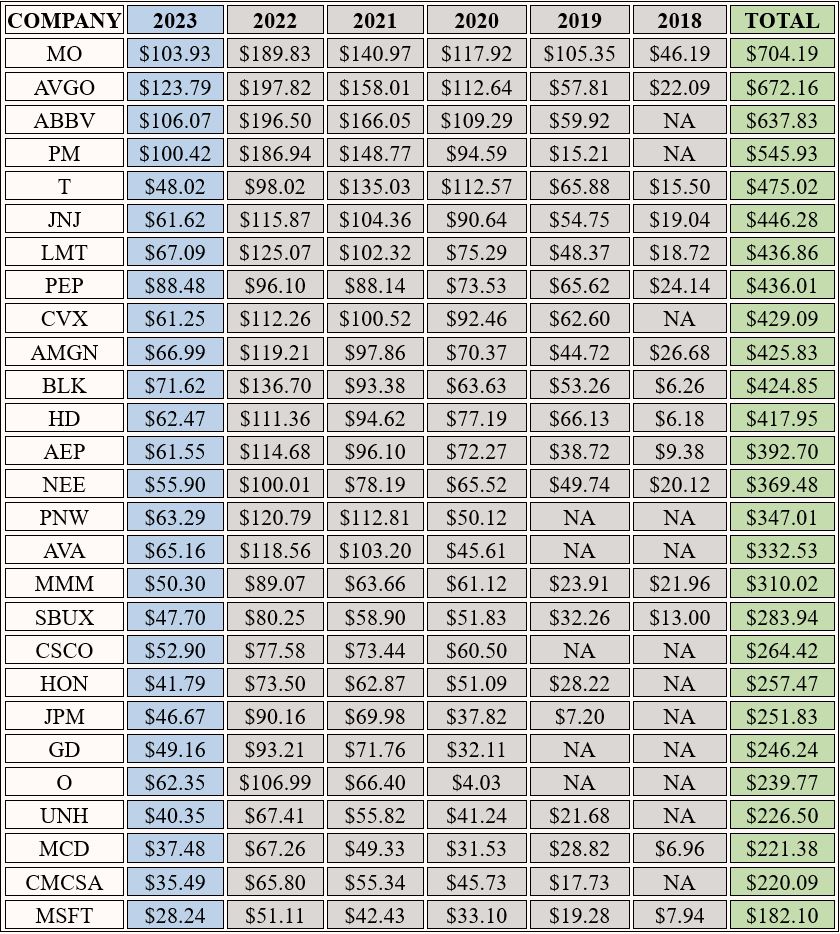


Obviously, 2023 was only half-finished at the time the IBP’s income target was reached, so it’s pretty easy to see that it was going to be another year of banner growth.
If we kept the project going the exact same way — including Greg’s $2,000 monthly investment — here is a projection of how the income stream would have grown:

SimplySafeDividends.com
As the graphic shows, with similar rates of dividend growth and reinvestment, the portfolio’s income stream would have swelled to about $45K annually in 15 years.
Given that DGI is a long-term strategy in which the compounding effect really takes off after 10-15 years, it’s not outlandish to believe that plenty of DGI practitioners have generated such huge streams — and even considerably larger ones — to help pay for their needs and wants.
The following table lists some other interesting income-related information about the IBP’s 51 stock positions:
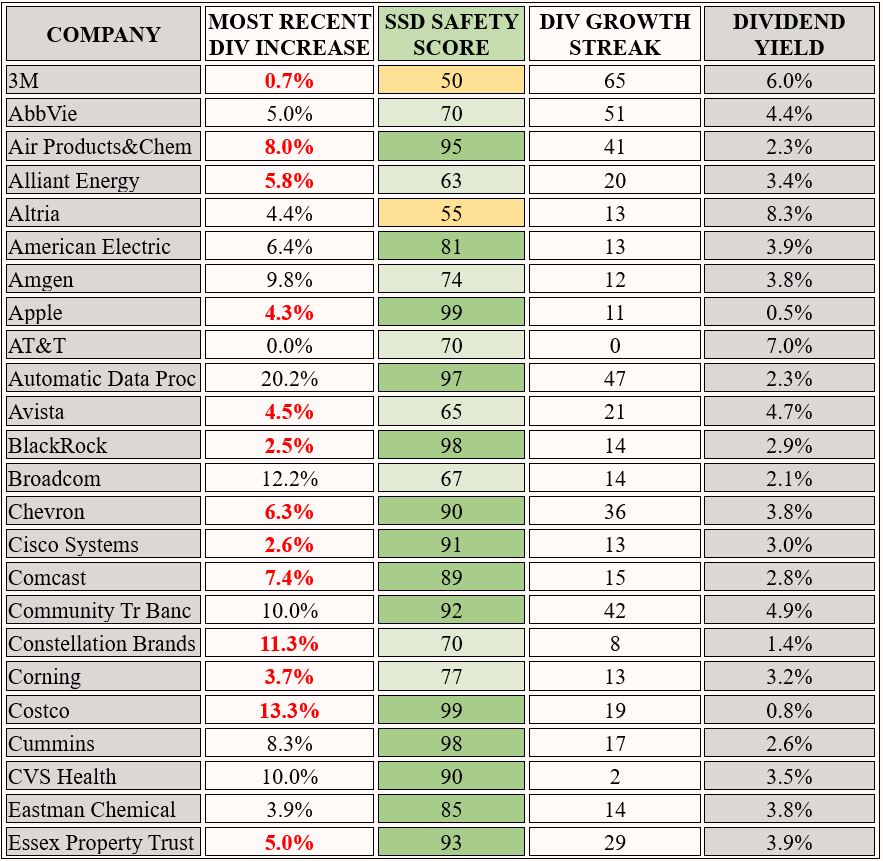

Red numbers in the “Most Recent Dividend Increase” column indicate raises that were made in the first half of 2023. Large investment banks Morgan Stanley (MS) and JPMorgan Chase (JPM) announced their increases on the very last day of June.
“SSD Safety Score” shows how secure Simply Safe Dividends calculates each position’s dividend to be using the following scale:

Overall, Simply Safe Dividends says 85% of the IBP’s income is “likely safe.”
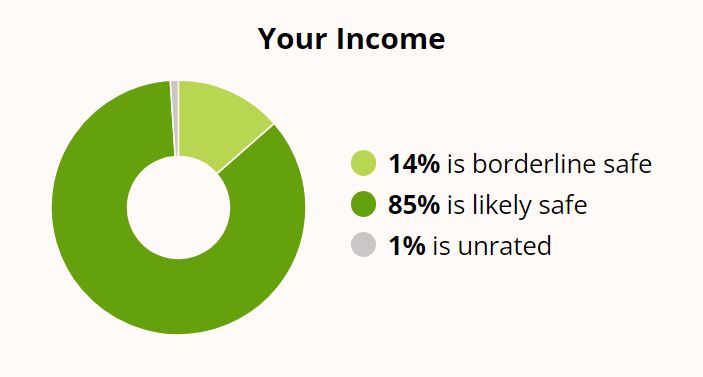
SimplySafeDividends.com
Total Return Report
Even as I selected stocks with our income target in mind, I always kept an eye on total return.
I tried to focus primarily on fundamentally sound and reasonably valued (or undervalued) companies with growing earnings, revenue and free cash flow. The results speak for themselves: total return that beat the Dow, just about matched the S&P 500, and significantly outperformed the kind of balanced portfolios popular with millions of investors.
Here were the IBP’s leaders in total return through June 30, 2023:
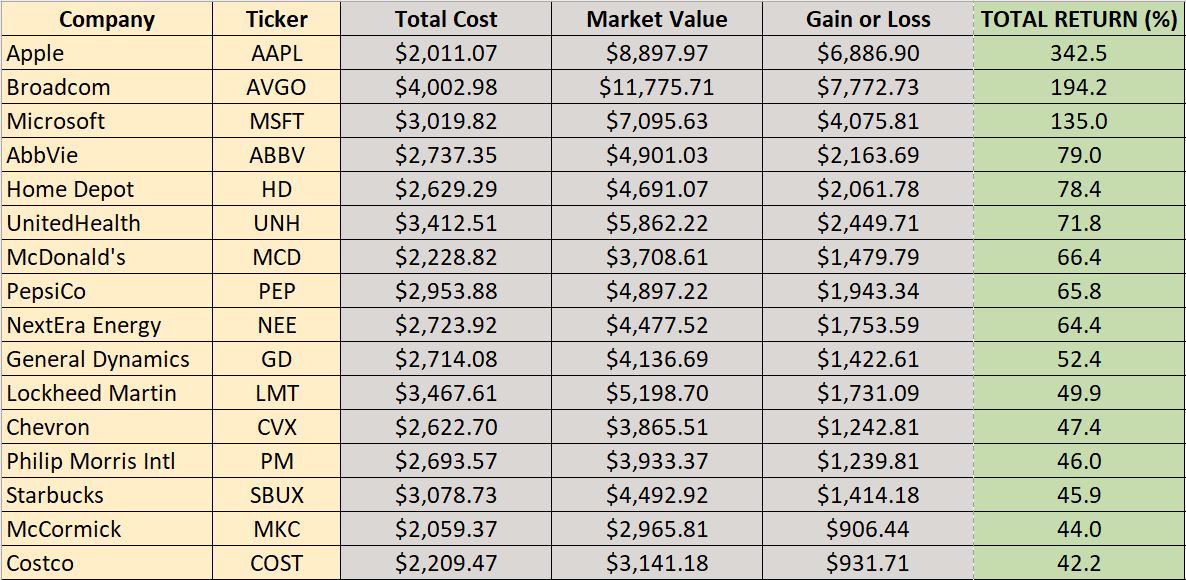
One thing I like about that leaderboard is the diversity of sectors and industries.
It’s no surprise that technology led the way, with our Apple (AAPL) position especially putting up eye-popping numbers. But then there were health-care companies in AbbVie (ABBV) and UnitedHealth (UNH); consumer discretionary businesses in Home Depot (HD), McDonald’s (MCD) and Starbucks (SBUX); industrials in General Dynamics (GD) and Lockheed Martin (LMT); utility NextEra (NEE); big oil’s Chevron (CVX); and several consumer staples, paced by Pepsi (PEP).
Broadcom (AVGO), one of the world’s largest semiconductor companies, was probably the IBP’s MVP at our $5K income-target mark. Not only was AVGO second in total return with its awesome 194% showing, it also was the portfolio’s largest income generator.
We made our first AVGO buy back on Aug. 14, 2018, and WOW did that grow into a market-mashing monster!

Thankfully, I selected Broadcom several more times for the IBP, most recently in December 2022. Over the next 7 months, even that buy experienced 65% total return. What a beast!
OK, I’ve talked about the stars … now what about the duds?
Struggling industrial conglomerate 3M (MMM) was one of my early picks, and its stock price did little but go down as the company dealt with falling earnings, lawsuits and a litany of other problems. It took up the rear with a total return of minus-38%.

There were five double-digit-percentage losers as the IBP project reached the end of its first phase, but it’s important to note that they didn’t derail the portfolio.
No investor is perfect. Not Warren Buffett, not Peter Lynch, not Benjamin Graham, and not that annoying bore at the party who claimed to have scored 1,000% gains on every trade he’s ever made.
Each of us is likely to have a few clunkers, but the key is that the overall portfolio does its job. And despite me choosing a few stocks that turned out to be laggards, IBP money man Greg Patrick is pretty darn happy we reached our $5K income target well ahead of schedule while posting competitive total return.
Wrapping Things Up
Greg and I were thinking that hitting our target would mark the end of the Income Builder Portfolio, but I’m excited to report that we’ve decided to keep it going indefinitely — with one notable change.
Although he remains totally committed to the IBP, Greg also is working on other projects, so he will be reducing his monthly allocation to $500. That will still be plenty to keep growing the portfolio and its income stream through my stock selections, dividend raises, reinvestments and capital gains.
The IBP has never been about us trying to convince fellow investors to replicate the portfolio’s holdings, anyway. As the Business Plan states:
This project is about presenting interesting investment candidates for further research, about discussing concepts and principles, and about demonstrating the process of building a reliable, growing income stream through DGI.
Phase 1 is complete, and it was a resounding success. Let the building continue!
— Mike Nadel
Better Than Dividend Stocks? [sponsor]The best way to earn monthly income is NOT a stock, bond or option... Rather, it's this little-known alternative investment. CLICK HERE TO FIND OUT MORE.
Source: Dividends & Income

